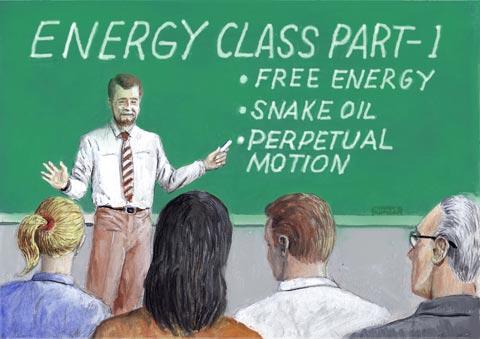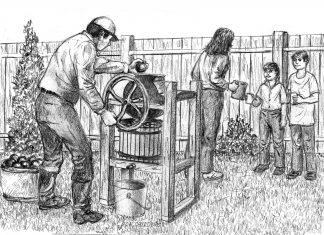 |
|
| Issue #111 • May/June, 2008 |
Each fall when my dad took us to the State Fair, we could always count on this fast-talking salesman standing next to his car with a big egg-shaped microphone hanging around his neck. The hood was up and the engine would be running. A big meter was hanging from the hood indicating engine RPM. He would quickly pull the ignition wire off the distributor, hopefully without killing the engine, and insert this little device that looked like a tiny torpedo with a plug on each end.
As soon as he inserted this device, the engine’s RPM magically went up due to what he called a “hotter spark,” and of course this just had to improve your gas mileage if you bought one. In reality, the faster his engine ran, the more gasoline it would actually consume, but that energy relationship was never explained and gas flow was not metered. I don’t know what happened to this guy years later when cars became computer-controlled, but I always thought he ended up living on a yacht somewhere in the Mediterranean, after selling thousands of those worthless devices.
Times have changed, but the same hawkers are out there selling all kinds of energy saving gizmos that are claimed to drastically cut your monthly utility bills. I am hoping this series of articles will make you a better consumer of energy, and will help you learn how to recognize these modern-day snake oil salesmen and their perpetual motion machines.
I receive many calls and website questions regarding energy, and most of these questions relate to a misunderstanding of how energy actually works. This is one subject most people were never taught in school, yet we are inundated every day with energy-related ads, products, and government-mandated energy regulations that affect these decisions. Although most people do not consciously think about it, energy is one of the most expensive items in their monthly budget. Energy is the gasoline to power our cars and chain saws, to heat and cool our homes, the electricity to power our lights, appliances, and refrigerators, and the power to recharge our cell phones, power tools, and trolling motors.
Energy prices also significantly impact the cost of manufacturing, packaging, and transporting everything you buy, including all you eat. Even if you grow most of your own food, you still require lots of energy to plow, till, harvest, and refrigerate these crops. I bet you know the current price for gasoline and what your weekly commute is costing. However, even though your home’s utility bills represent a much higher energy cost, most people do not know what their energy costs are, or how to use this energy more effectively.
For example, do you know what you are paying for each “kilowatt-hour” of electricity you consume, and is this cost high, low, or average for a home like yours? If you heat by gas, do you know what you are paying for a “therm” or cubic foot, and is this cost high, low, or average? If you heat with propane or oil and are billed each time they fill your tank, how many gallons do you burn per month and is this reasonable?
Your monthly utility bills are probably costing more this year than last year, but are these cost increases due to a higher fuel cost, higher usage, or both? Utility prices do fluctuate, and natural gas, propane, and fuel oil have experienced major price increases in recent years. Electric rates nationally have been fairly stable for almost 10-years, but there have been significant price increases in the past year in several states, and major rate hikes are already being discussed in many others.
When the cost of gasoline went from $1.00 per gallon to over $3.00 per gallon in less than five years, you knew exactly what to do. You gradually cut your nonessential travel, then combined multiple short errands into one, and finally traded in that gas guzzler for a more fuel-efficient car or truck. So if you understand how to reduce these energy costs, why do you continue to pay whatever you are billed for utilities, without even considering there are similar steps you can take to reduce these energy costs as well?
Let’s start with some basic energy rules. Thermal energy “flows” from hot to cold, and not the other way around. You are trying to heat your house because interior heat is moving out to the colder outside, and the poorer the insulation, the faster this energy will move. You air condition your home because the hot outside air and solar radiation through windows are driving heat energy into your cooler home, and not because the cold is somehow escaping out.
The next basic energy rule we need to review is how heat flow depends only on the temperature difference, the U-value of the insulation separating the inside and outside, and the surface areas. The “U” factor is just the inverse of the “R” factor, which is usually printed on the insulation. For example, R-19 batt insulation used in many walls has a “U” factor of 0.0526, (1/19 mathematically). This is the basic calculation for heat loss or heat gain through all walls, ceilings, roofs, floors, and window glass.
Heat loss = area × U factor × temperature difference
I’m not going to bore you with heat-flow calculation examples, but you get the concept. Since the surface area of your home’s exterior is fixed, unless you add more insulation, the heat loss or gain of your home will be due entirely to the difference in temperature between the inside and outside. Refer back to the above formula. If we skip any consideration of air infiltration or latent heat effects, it takes the same amount of energy for each degree we heat up or cool down our homes based on this basic law of heat transfer.
In other words, it takes the same amount of energy to heat your home from 60° to 61°F, as it takes to heat it from 70° to 71°F. It takes the same amount of energy to cool your home from 80° to 79°F as it does from 76° to 75°F, as long as we ignore any changes in latent heat (humidity). If we light a match anywhere inside our home during the winter, the heat from this match will eventually find its way outside, totally as a function of your exterior surface areas, and the insulation value of these areas since the match is hotter than the outside. Of course this is an extreme example, and I am ignoring air infiltration losses through cracks and openings.
I think we are now ready for some real-life examples. Based on what you have just learned, why do most people think they can buy a small portable electric heater or fake fireplace and heat their entire home? Yet the ads say you can turn down your home’s thermostat and sit comfortably in front of this glowing heater and save hundreds of dollars each month. Yes, in a cool room if you sit three feet from any brand heater you will feel warm. However, while you sit there, the rest of your house is getting colder and colder, and it will never recover the lost heat unless you add the same amount of heat back.
Remembering our earlier energy lesson, turning down your thermostat one degree will save the same energy it will take to heat it up again one degree. The only way your home can be heated back up to the previous temperature after you let it drop to save energy is to consume the same amount of energy per degree drop. For those hours your home stays at this setback temperature, it is true that you are saving this given amount of energy each hour. It should now be obvious that this is far more energy than any magic portable heater can ever provide. Those too-good-to-be-true ads say their heaters use the same electricity as your electric coffee pot, which sounds like a tiny amount. However, an electric coffee pot is one of the highest electric loads in your home, but it doesn’t cost much to make a pot of coffee because you only perk water for a few minutes each day. Imagine what it would cost to continuously boil coffee water 24 hours a day!
Let’s have a reality check. Unless we are talking about a heat pump, a resistance-type electric heater can only produce 3,413 BTUs of heat per kilowatt, because that is the heat value of a kilowatt of electricity. I don’t care if these magic heaters glow red, are filled with special heat transfer oils, have reflectors that look like radar dishes, or blow hot air from a fake log fire, 3,413 BTUs is all you get from a kilowatt of electricity. If an electric heater is rated at 2 kilowatts (2,000 watts), you get 6,826 BTUs (2 × 3,413) of heat, which is about as large as they can make these portable heaters due to safety limitations on the heater’s power cord and the current-carrying capacity of your wall outlet.
Since a typical residential furnace will have a heating capacity in the 80,000 to 125,000 BTU/hr range, you can see how your magic heater would need to operate almost 30 hours to produce the same heat your central furnace can produce in one hour.
Now for those of you who are yelling at me that it’s cheaper to let your home cool down and only heat the room where you are sitting, you are almost correct. But you assume your house stays at the lower temperature. What actually happens when you lower your house thermostat from 70° to 68°? Once the interior temperature drops to 68° it does not stay there. During the winter, the interior temperature will continue to fall if no additional heat is added. So where does the heat come from to keep your house at the lower 68° without falling any further? At some point the 70° room you are sitting in with your magic heater will get colder and colder due to the cooling of the rest of the house. I think the salespeople hope by this time you have given up and crawled into bed under heavy blankets to dream about all the money you are saving.
If we have two identical homes located side-by-side, and one home was held all winter at 68°F and the other home was held at 70°F, it is true the lower temperature home will save the amount of energy the other home is using to maintain the interior two degrees warmer for each hour it stays at this temperature. Obviously, if you decide to live with a colder home, you can sit all day directly in front of your magic heater while the rest of your home is cold. However, don’t expect your entire home to also stay warm, and don’t think this magic heater is not the reason your electric meter is spinning.
Do I own one of these magic heaters? Yes, and I use it occasionally to offset a cold room or add a little heat under my office desk on an extra cold day that is taxing my central heating system. But the difference is, I’m not expecting it to save anything on my heating bill. It is using electricity and that costs money!
Will lowering your thermostat save on your heating bill? Of course, but only for those hours you maintain the lower temperature. If you want a magic box heater to keep your immediate area warmer when the rest of the house is cold, then go for it. Just don’t think you can use this little magic heater to heat your entire home for pennies-per-day.
In Part II of this series, I will explain how to actually read your monthly utility bill, how to determine your actual energy usage, and how to identify major energy problems using only your monthly utility bills.
In the final Part III of this series, you will learn how to take control of your home’s energy costs, just like you took control of your transportation energy costs. Your assignment before our next issue is to dig through your old receipts and put together a minimum of 12 months of utility bills. If you can’t find them, contact your electric or fuel supplier for copies.
[weaver_widget_area id=’articles_about_yago’ class=’text3′]














